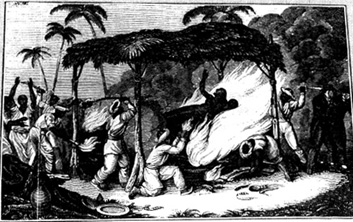Pain and Transformation

Etching depicting a sati, from James Peggs, India's Cries to British Humanity |
What connects the three aspects of sati: the practice, the Goddess, and the
woman who burns is the idea that pain is used as a transformative process in all
three. As I explained in the section on Sati the Goddess, the painful death and
destruction of Sati's body is what transforms ´Siva, her husband from an ascetic god
to a worldly god. By looking at the Sati myth, we can see how all satis create a
transformation in their husbands, granting them a better afterlife. |
Sati's literal
dismemberment also changes the very earth itself. Her fallen body sacrilizes the
earth, infusing it with divine potency while also creating a new venue for believers
to worship ´Siva and Sati. This idea of a woman's destroyed body sanctifying the
earth continues in India today. Why else would pilgrims come to simply stand on
the earth Roop Kanwar's body was burnt on? And why else would Kanwar's
husband's family decide to build the funeral pyre next to their house as opposed to
the more traditional site of the cremation grounds? Clearly these acts can be
evidence of the way the physical act of mutilation of a body consecrates the earth it
touches.
If the myth of sati uses pain as a transformative process, then the practice of
sati and the woman who burns can clearly be seen as sites where the importance of
pain needs to be examined. I will use Elaine Scarry's theories on pain, and
Rajeswari Sunder Rajan's important essay The Subject of Sati to formulate a brief
theory on how pain is used in sati to transform the self, the people involved and
how it ultimately creates a goddess.
Scarry believes that pain itself is what creates the human subject, "Man can
only be created once, but once created he can be endlessly modified; wounding re
enacts the power of alteration that had its first profound occurrence in creation"12.
Scarry's idea that pain and wounding recreates man, (more appropriately woman in
my case) is central to my theory that pain itself is what transforms a sati into a
goddess. This act of pain works not only to recreate the self, as Scarry suggests, but
in the practice of sati it is the pain of burning flesh that transforms a woman in a
desperate situation(that of being a widow) into a divine being.
Sati supporters authoritatively speak of the absence or transcendence of pain
that is felt by a sati. Their proof is the calm smile on her face as she burns, and they
point to sat as the energy which not only lights the fire but dispels the pain13. Yet it
is the ability of a sati the withstand the pain of flames that draws entire villages to
watch a sati burn. If she truly did not feel pain, there would be no sacrifice
involved, and satis would not be worshipped so highly. It is the pain that causes the
spectacle. It is her endurance of pain that the onlookers admire about a sati. In this
way, it is the collective act of audience and subject that creates a goddess. The pain
transforms a sati herself: destroying her body, sending her into the next life; but it is
the observance and admiration of her pain that transforms the audience into
satimata believers. It is because of their respect for her pain that people worship a
sati, it is their worship that creates a goddess.
It is through the practice of sati that woman as a subject, experiences pain. It
is her pain that transforms those around her, her husband and the onlookers. It is
pain that ultimately transforms her self. Through the observance of her pain a set
of devotees are created, and they transform her into a goddess. Her burning body is
what destroys her former self, that of a wife, and it is what creates her new self- a
goddess.
